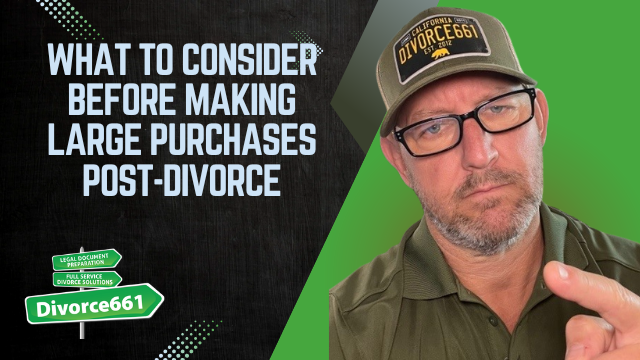What to Consider Before Making Large Purchases Post-Divorce? | Los Angeles Divorce
Introduction
I’m Tim Blankenship from Divorce661. If you’re newly single, the urge to make big purchases after divorce is completely natural — you want a fresh start. But emotional spending can quickly turn a hopeful new chapter into a financial setback. Below I’ll walk you through how to recognize the emotional triggers that drive impulsive purchases, how to realistically assess your finances, and practical steps to make smart, future-focused decisions.
Why We Buy After Divorce: Emotional Triggers to Watch For
Divorce is an emotional watershed. New independence, grief, relief, anger, or the desire to “start over” can push you toward expensive choices: a new car, a full home makeover, or designer furniture. Recognizing these emotional triggers is the first step to avoiding impulsive decisions that don’t match your financial reality.
Before you buy, pause and ask: Am I buying this because it solves a real need, or because it soothes an emotion? A short cool-down period can save you months — or years — of financial strain.
Step 1 — Assess Your Financial Stability
Start with a clear inventory of your money situation. Key items to identify:
- Monthly income (including any support payments)
- Fixed monthly expenses and new or existing debts
- Savings and emergency fund balance
- Credit card balances and interest rates
- Any upcoming large expenses (moving costs, legal fees, healthcare)
If you’re now on a single income, your budget needs to reflect that reality. Factor in support payments, potential tax implications, and any new debts you’ve taken on. The goal is to ensure your budget can handle long-term costs without putting you at risk.
Step 2 — Make Your Budget Robust Enough for New Expenses
When considering a large purchase, test it against your budget’s long-term picture: can you still fund retirement, emergency savings, and monthly living expenses if you add this payment?
Some practical rules to follow:
- Keep an emergency fund of 3–6 months living expenses before making large discretionary purchases.
- Avoid opening new high-interest credit for non-essential items when you’re rebuilding credit.
- Automate savings and debt-paydown so long-term goals continue even when life feels chaotic.
Step 3 — Align Purchases with Long-Term Goals
Ask whether the purchase helps or hinders your long-term plans. If your priority is rebuilding credit, paying down debt, or saving for a home, a big credit purchase probably contradicts those goals.
Always evaluate: Will this expense bring lasting value or just temporary satisfaction? If it’s the latter, consider scaling back or delaying it until your financial foundation is stronger.
Real Client Example — Small Changes, Big Impact
One client came to me overwhelmed — reduced income and mounting debt. She desperately wanted to fully furnish her new place immediately. Instead, we scaled back the furnishing plan. She bought essentials first and staged other purchases over months. That decision kept her from taking on more debt and gave her breathing room when unexpected expenses came up.
That example shows how modest compromises now can preserve flexibility and avoid long-term setbacks.
Practical Pre-Purchase Checklist
- Wait 30 days before any non-essential purchase. If you still want it after that period, revisit the decision.
- Confirm you have a 3–6 month emergency fund intact.
- Run the numbers: can your budget absorb the new payment for the next 3–5 years?
- Check alternatives: can you buy used, lease, or finance at a lower rate?
- Consider opportunity cost: will this purchase delay paying off high-interest debt or saving for retirement?
- If financing, read the terms carefully — interest rates, penalties, and total cost matter.
How Divorce661 Helps
At Divorce661 we provide practical, post-divorce financial advice with flat-fee pricing and 100% remote guidance. We give you personalized financial checklists and recovery tools, help automate savings and debt reduction, and guide you step-by-step so your decisions move you forward — not backwards.
If you want a partner to build a realistic recovery plan and help you make informed decisions about big purchases, schedule a free consultation with Divorce661. Our goal is to ensure your post-divorce journey is a step forward, not a financial setback.
Conclusion
Big purchases after divorce can feel empowering, but they also carry real financial risk. Recognize emotional triggers, assess your financial stability honestly, and align any major purchases with your long-term goals. Small, deliberate choices now will protect your future—and help you rebuild with confidence.
Let’s make your post-divorce journey a step forward, not a financial setback.







